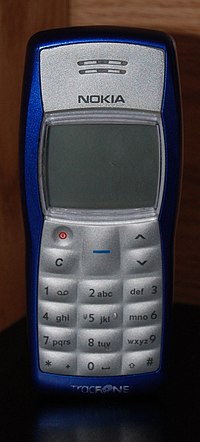Nokia 1100
 |
|
| Manufacturer | Nokia |
|---|---|
| Availability by country | 2003 |
| Predecessor | Nokia 3310 |
| Successor | Nokia 1110 |
| Related | Nokia 2100 |
| Form factor | candybar |
| Dimensions | 106 × 46 × 20 mm, 79 cc |
| Weight | 86 g |
| Memory | dynamic phonebook memory: • 50 slots/contacts, • 50 SMS messages |
| Battery | Nokia BL-5C • Standby time 400 h |
| Data inputs | Keypad (dustproof)waterproof |
| Display | Monochrome, 96 × 65 px |
| Other | Built-in flashlight Clock alarm Stopwatch Calculator composer screensaver |
The Nokia 1100 (and closely related variants, the Nokia 1101 and the Nokia 1108) is a basic GSM mobile phone produced by Nokia. Over 250 million 1100s have been sold since its launch in late 2003, making it the world's best selling phone handset and the best selling consumer electronics device in the world at the time. The model was discontinued in 2009.
The 1100 achieved its popularity despite being made during a time when more modern mobile phones with more features (e.g. colour screen, internal camera) were available in the market. It was targeted towards developing countries and users who do not require advanced features beyond making calls and SMS text messages, alarm clock, reminders, etc.
The 1100 is similar to the discontinued 5110/3210/3310 models that were among the most popular mobile phones in the world during their time, before handsets developed several new features such as cameras, polyphonic ringtones and colour screens.
The Nokia 1100 was designed at Nokia Design Center in California, and patented for the US by the Bulgarian-American designer Dimitre Mehandjiysky.
Nokia's one billionth phone sold was a Nokia 1100 purchased in Nigeria in 2005.
In early 2009, it was in the news due to a firmware flaw in a batch of phones that were manufactured in a plant in Bochum, Germany. The phone could supposedly be programmed to receive messages directed to a different phone number, thus receiving sensitive data such as online banking details. This flaw was brought to authorities' attention after some phones were sold for over US$32,000.
There are four distinct variations within the series: the 1100a, 1100b, 1101 and the 1108. They differ as follows:
The phone's firmware version can be checked by dialling *#0000#.
The phone uses a GSM method of activation via a SIM card. The Nokia BL-5C battery has a long standby and talk time – this battery is used in more advanced models that have increased power needs for their features, but in the basic 1100 it consumes a fraction of the power and therefore lasts for up to 400 hours between charges. The phone is offered for use with a wide range of mobile phone networks.
...
Wikipedia
